Effect of U-Turns and Heavy Vehicles on the Saturation Flow Rates of Left-Turn Lanes at Signalized Intersections
Abstract
1. Introduction
2. Literature Review
3. Methodology
3.1. Description of Selected Sites
3.2. Data Collection and Extraction
- The queue discharge time was measured from after the 4th vehicle passed the stop line until the last vehicle in the queue passed the stop line during the green light interval.
- The number of heavy vehicles and their effect on other vehicle movements and time headway was taken into account.
- Cycles containing a platoon of weaving vehicles were excluded.
- Cycles in which vehicle platoons were impeded by pedestrians, cyclists, or motorcyclists were excluded.
- Cycles with less than eight vehicles in the queue were excluded.
- Cycles where the upstream queue affected the movement of the discharging vehicles were excluded.
4. Data Analysis and Results
4.1. Characteristics of Headways
- A leading left-turning vehicle is followed by a left-turning vehicle (LT-LT)
- A leading U-turning vehicle is followed by a left-turning vehicle (LT-U)
- A leading left-turning vehicle is followed by a U-turning vehicle (U-LT)
- A leading U-turning vehicle is followed by a U-turning vehicle (U-U)
- Both leading and following vehicles are either a SUV or Sedan (SS-SS)
- A leading heavy vehicle is followed by a SUV or Sedan (SS-HV)
- A leading SUV or Sedan is followed by a heavy vehicle (HV-SS)
- A leading heavy vehicle is followed by a heavy vehicle (HV-HV)
4.2. Base Saturation Flow Rates
4.3. Effect of Heavy Vehicles
4.4. Effect U-Turning Vehicles
5. Conclusions and Recommendations
Author Contributions
Funding
Acknowledgments
Conflicts of Interest
References
- Highway Capacity Manual; Transportation Research Board: Washington, DC, USA, 2016.
- Hamad, K.; Abuhamda, H. Estimating base saturation flow rate for selected signalized intersections in Doha, Qatar. J. Traffic Logist. Eng. 2015, 3, 168–171. [Google Scholar] [CrossRef]
- Al-Ghamdi, A.S. Entering headway for through movements at urban signalized intersectionsl. Transp. Res. Rec. 1999, 1678, 42–47. [Google Scholar] [CrossRef]
- Alam, M.J.B.; Osra, K.A.; Al-Bar, H.O.; Zahran, S.Z. Signalized intersection capacity adjustment factors for Makkah, Saudi Arabia. Can. J. Transp. 2010, 4, 55–66. [Google Scholar]
- Al-Omari, B.H.; Musa, Y.B. Aggressive driving effect on signalized intersections saturation flow rates in developing countries. In Proceedings of the 7th Traffic Safety Conference, Amman, Jordan, 12–13 May 2015. [Google Scholar]
- Mohseni, P.; Boroujerdian, A.M. Analysis of the impact of users violations on the saturation flow rate at signalized intersections. Int. J. Transp. Eng. 2018, 6, 145–156. [Google Scholar]
- Dündar, S.; Öğüt, K.S. Determination of basic saturation flow rates in Istanbul. Int. J. Eng. Technol. 2018, 4, 47–52. [Google Scholar]
- Stanić, B.; Tubić, V.; Čelar, N. Straight lane saturation flow and its rate in Serbian cities. Transport 2011, 26, 329–333. [Google Scholar] [CrossRef]
- Rahman, M.M.; Ahmed, S.N.; Hassan, T. Comparison of saturation flow rate at signalized intersections in Yokohama and Dhaka. In Proceedings of the Eastern Asia Society for Transportation Studies, Bangkok, Thailand, 22 September 2005; Volume 5, pp. 959–966. [Google Scholar]
- Mukwaya, R.; Mwesige, G. Saturation Flow Rate for Through-Traffic at Signalized Junctions in Kampala. In Proceedings of the Second International Conference on Advances in Engineering and Technology, Entebbe, Uganda, 31 January–1 February 2011; Volume 135, pp. 253–259. [Google Scholar]
- Hussain, A.M. Determination of saturation flows at signalized intersections in Malaysian urban areas. In Proceedings of the 6th REAAA Conference, Kuala Lumpur, Malaysia, 4–10 March 1990; Volume 2, pp. 1406–1413. [Google Scholar]
- Hussayin, A.S.; Shoukry, W.S. Saturation flow and effective approach width at signalized intersections in Greater Cairo. In Proceedings of the 6th African Highway IRF Conference, Cairo, Egypt, 21–26 September 1986. [Google Scholar]
- Coeymas, J.E.; Meely, C.B. Basic Traffic Parameters in the Case of Santiago; Transport and Road Research Laboratory (TRRL): Wokingham, UK, 1988. [Google Scholar]
- Lee, H.S.; Do, T.W. Saturation headway of through movement at signalized intersections in urban area. J. Transp. Res. Soc. Korea 2002, 20, 23–31. [Google Scholar]
- De Andrade, J.P. The Performance of Urban Intersections in Brazil. Transportation Research Group. Ph.D. Thesis, Department of Civil Engineering, University of Southampton, Southampton, UK, Unpublished work. 1988. [Google Scholar]
- Bester, C.J.; Meyers, W.L. Saturation Flow Rates. In Proceedings of the 26th Southern African Transport Conference, Pretoria, South Africa, 9–12 July 2007. [Google Scholar]
- Chand, S.; Gupta, N.J.; Velmurugan, S. Development of saturation flow model at signalized intersection for heterogeneous Traffic. Transp. Res. Procedia 2017, 25, 1662–1671. [Google Scholar] [CrossRef]
- Siddiqui, S. Investigating Saturation Flow Rate of Dual Left-Turn Lanes at Intersection Approaches. In Technical Report; Montana State University: Bozeman, MT, USA, 2015. [Google Scholar]
- Wang, M.H.; Benekohal, R. Analysis of left-turn saturation flow rates and capacity at signalized intersections. Transp. Res. Rec. 2010, 2173, 96–104. [Google Scholar] [CrossRef]
- Arhin, S.; Anderson, M.F.; Stinson, R.; Ribbiso, A. Prevailing saturation flow rate for lane groups in an urban area. Int. J. Traffic Transp. Eng. 2016, 6, 231–242. [Google Scholar] [CrossRef][Green Version]
- Chen, P.; Nakamura, H.; Asano, M. Saturation flow rate analysis for shared left-turn lane at ignalized intersections in Japan. Procedia Soc. Behav. Sci. 2011, 16, 548–559. [Google Scholar] [CrossRef]
- Liu, P.; Lu, J.; Fan, J.; Pernia, J.; Sokolow, G. Effects of U-turns on capacities of signalized intersections. J. Transp. Res. Board 2005, 1920, 74–80. [Google Scholar] [CrossRef]
- Shokry, S.; Tanaka, S. Evaluating the operational performance of signalized intersections involving U-turns in Aswan City, Egypt. J. East. Asia Soc. Transp. Stud. 2015, 11, 1754–1773. [Google Scholar]
- Adams, J.C.; Hummer, J.E. Effects of U-turns on left-turn saturation flow rates. Transp. Res. Rec. 1993, 1398, 90–100. [Google Scholar]
- Sun, H.; Yang, J.; Wang, L.; Li, L.; Wu, B. Saturation flow rate and start-up lost time of dual-left lanes at signalized intersection in rainy weather condition. Procedia Soc. Behav. Sci. 2013, 96, 270–279. [Google Scholar] [CrossRef]
- Chodur, J.; Ostrowski, K.; Tracz, M. Impact of saturation flow changes on performance of traffic lanes at signalised intersections. Procedia Soc. Behav. Sci. 2011, 16, 600–611. [Google Scholar] [CrossRef]
- Branston, D. Some factors affecting the capacity of signalised intersections. Traffic Eng. Control 1979, 20, 390–396. [Google Scholar]
- Shao, C.Q.; Rong, J.; Liu, X.M. Study on the saturation flow rate and its influence factors at signalized intersections in China. Procedia Soc. Behav. Sci. 2011, 16, 504–514. [Google Scholar] [CrossRef]
- Sando, T.; Moses, R. Influence of intersection geometrics on the operation of triple left-turn lanes. J. Transp. Eng. 2009, 135, 253–259. [Google Scholar] [CrossRef]
- Hashemi, A.H.; Nakamura, H.; Goto, A. Influence of downstream conditions over saturation flow rate. In Proceedings of the 37th Conference of Japan Society of Traffic Engineers, Fukuoka, Japan, 11–13 September 2017; pp. 467–472. [Google Scholar]
- Qin, Z.; Zhao, J.; Liang, S.; Yao, J. Impact of guideline markings on saturation flow rate at signalized intersections. J. Adv. Transp. 2019. [Google Scholar] [CrossRef]
- Lin, F.B. Left-Turn adjustment factors for saturation flow rates of shared permissive left-turn lanes. Transp. Res. Rec. 1992, 1365, 62–70. [Google Scholar]
- Prassas, E.S.; Roess, R.P. Left-turn adjustment for permitted turns from shared lane groups: Another look. Transp. Res. Rec. 1993, 1398, 75–81. [Google Scholar]
- Tsao, S.M.; Chu, S.W. A study on adjustment factors for U-turns in left-turn lanes at signalized intersections. J. Adv. Transp. 1995, 29, 183–192. [Google Scholar] [CrossRef]
- Carter, D.; Hummer, J.E.; Foyle, R.S.; Phillips, S. Operational and safety effects of U-turns at signalized intersections. Transp. Res. Rec. 2005, 1912, 11–18. [Google Scholar] [CrossRef]
- Cuddon, A.P.; Ogden, K.W. The effect of heavy vehicles on saturation flows at signalised intersections. In Proceedings of the 16th ARRB Conference, Perth, WA, Australia, 9–13 November 1992; Volume 16. [Google Scholar]
- Kockelman, K.M.; Shabih, R.A. Effect of light-duty trucks on the capacity of signalized intersections. J. Transp. Eng. 2000, 126, 506–512. [Google Scholar] [CrossRef]
- Zhang, G.; Chen, J. Study on saturation flow rates for signalized intersections. In Proceedings of the International Conference on Measuring Technology and Mechatronics Automation, Southeast University, Nanjing, China, 11–12 April 2009. [Google Scholar]
- Hamad, K.; Abu-Hamda, H. Determining u-turn adjustment factor for signalized intersections in Doha, Qatar. In Proceedings of the MATEC Web of Conferences, Sharjah, UAE, 18–20 April 2017; Volume 120, p. 07008. [Google Scholar] [CrossRef]

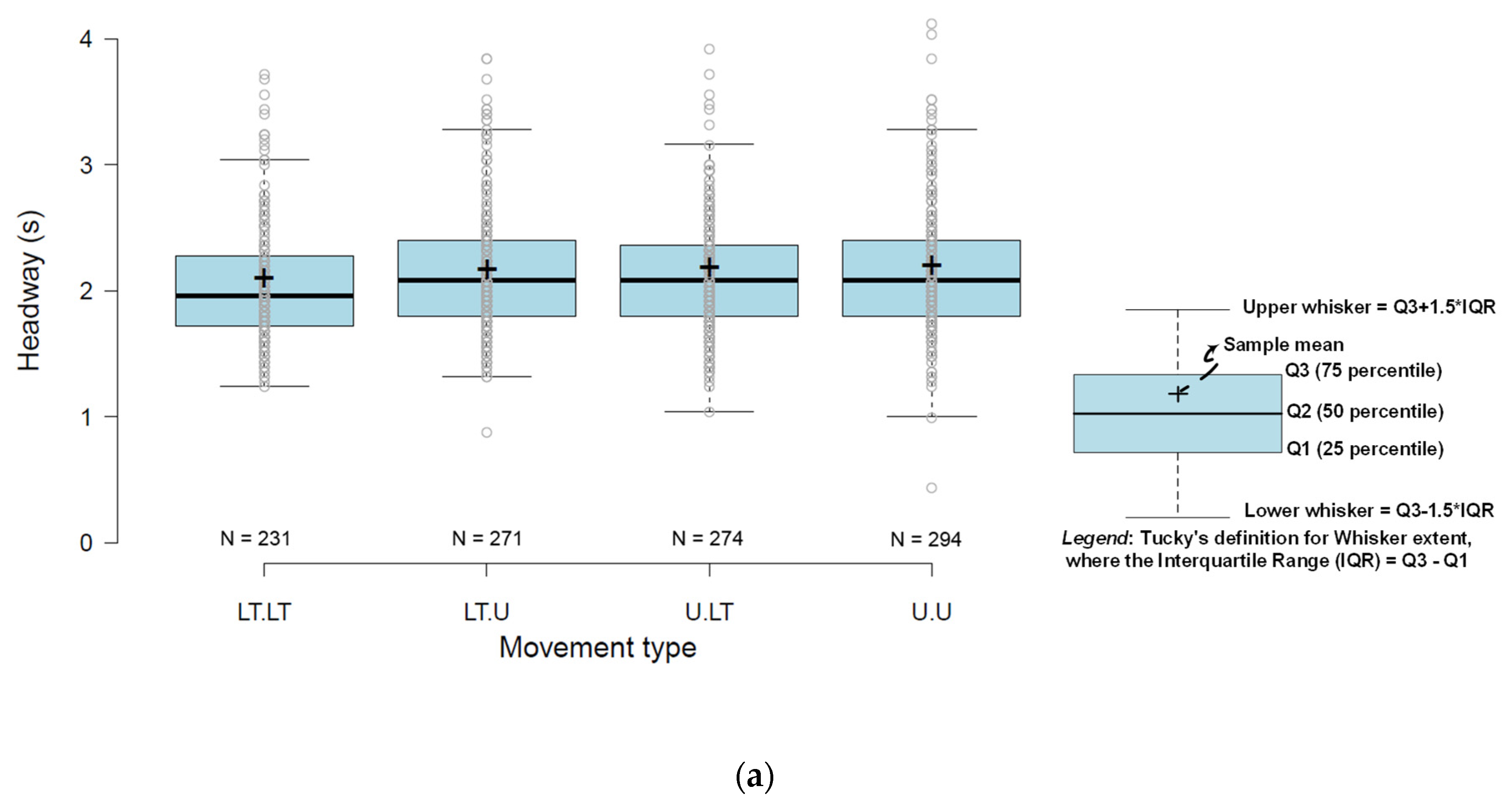
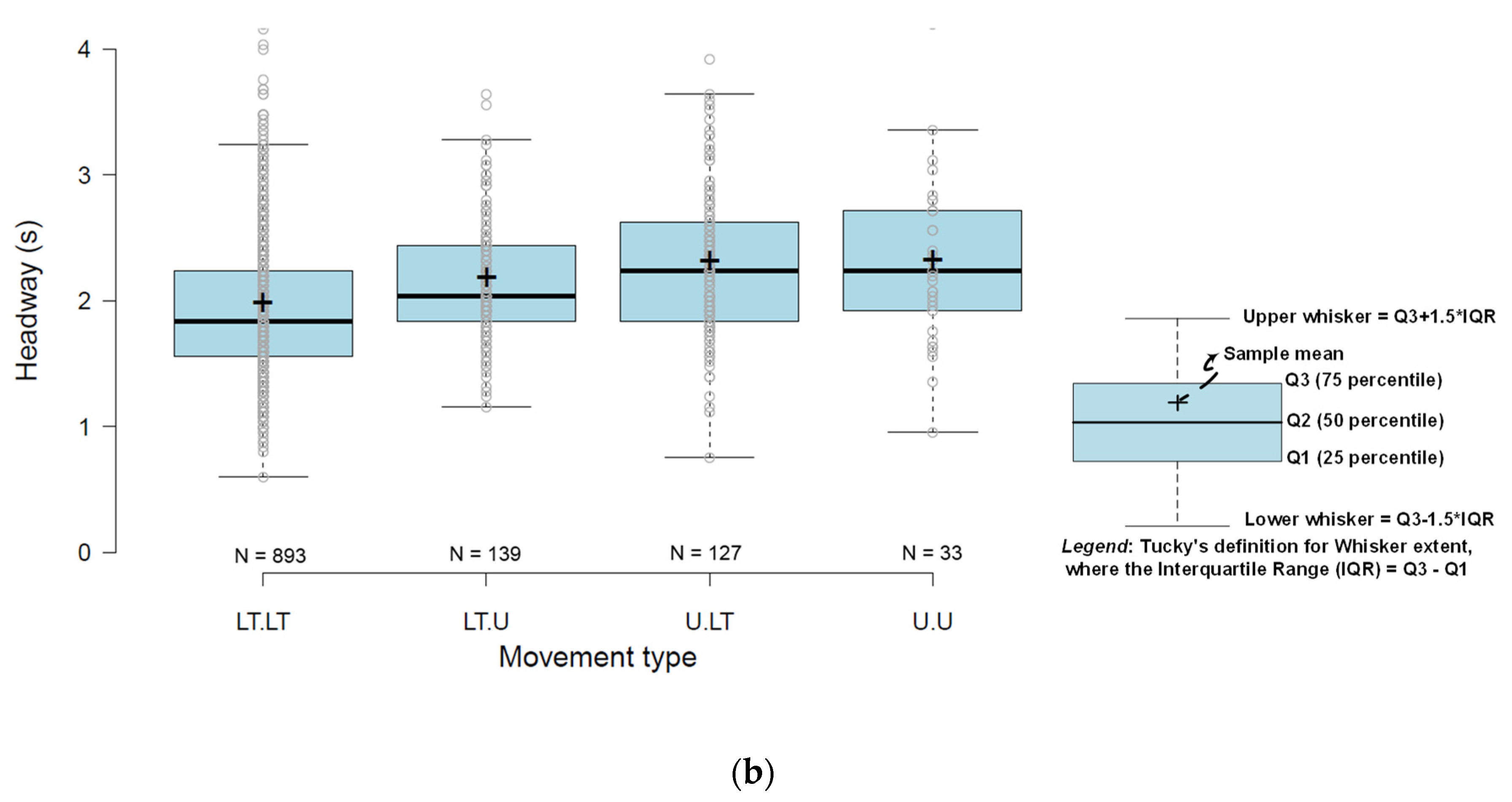

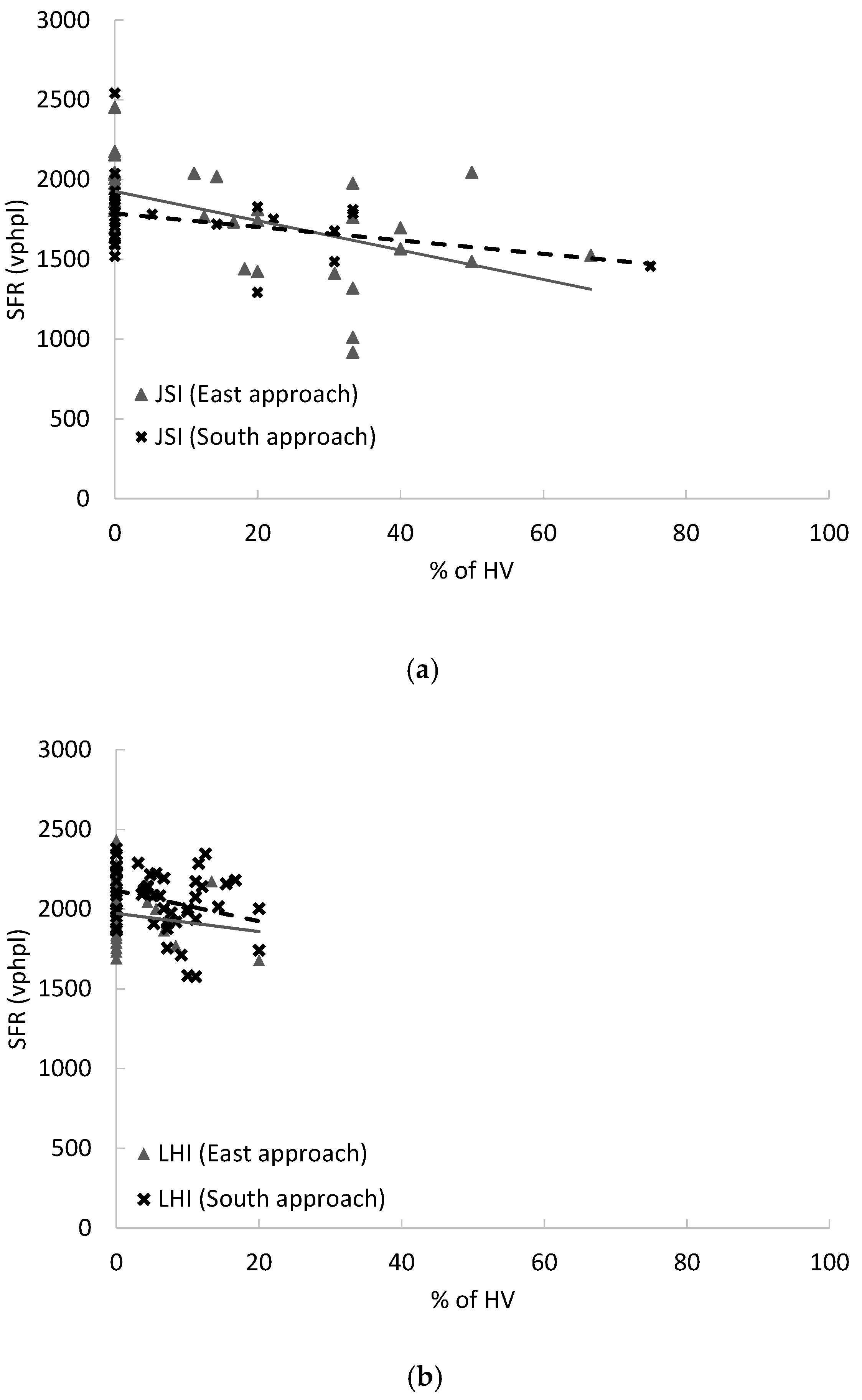
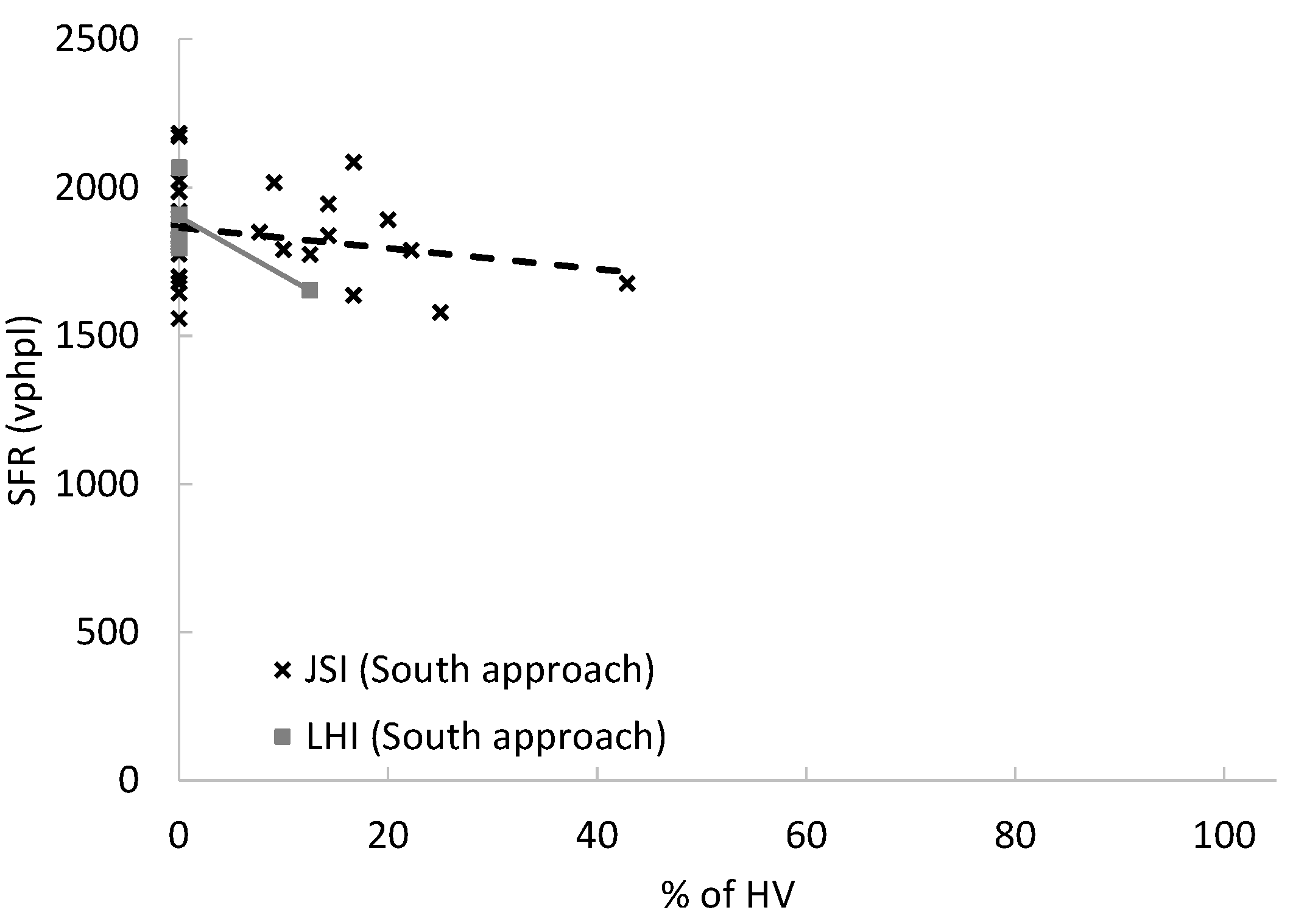
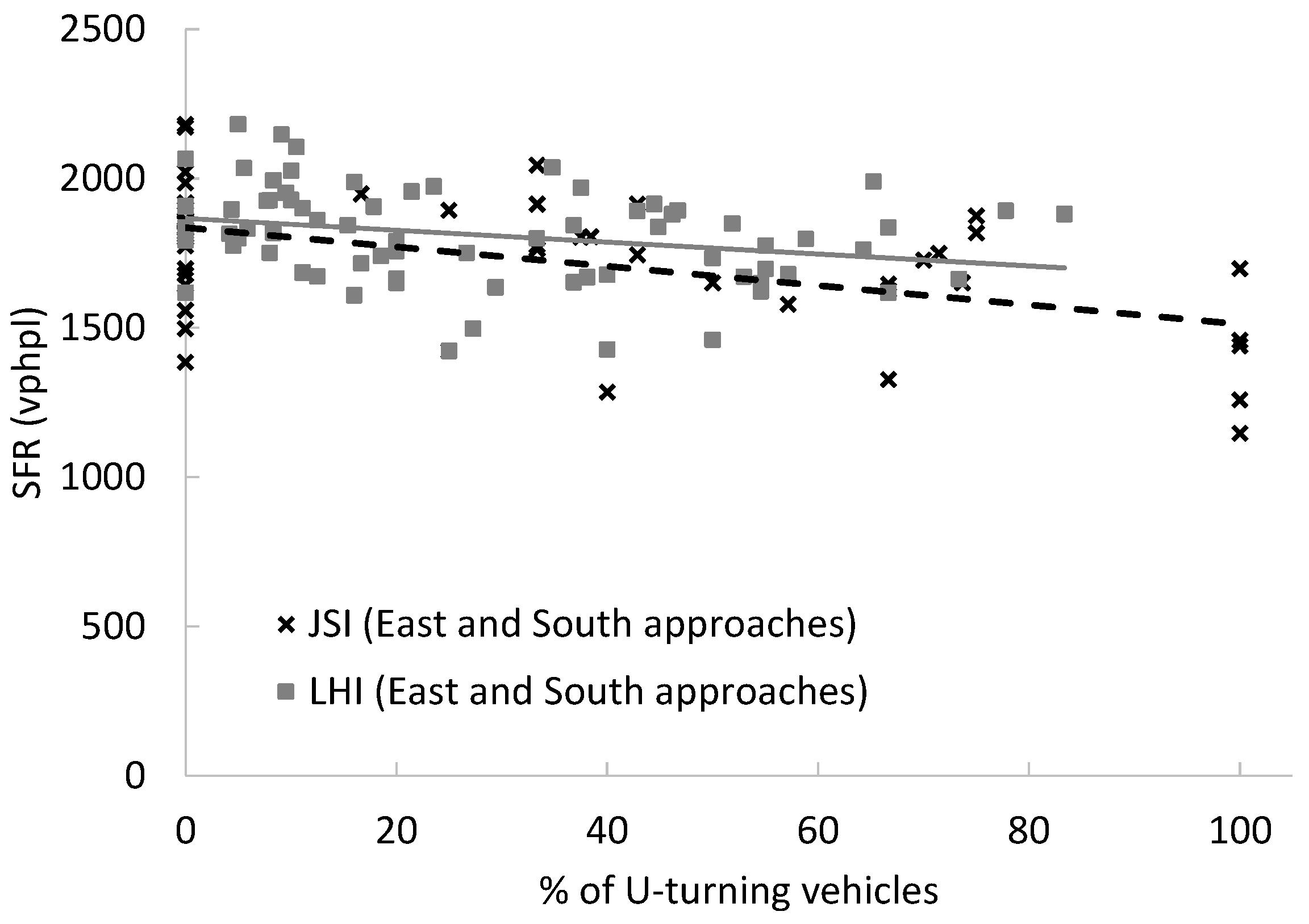
| Source | City/Country | Lane Movement | SFR (veh/h/ln) |
|---|---|---|---|
| Hamad and Abuhamda [2] | Doha, Qatar | TH | 2323 |
| Al-Ghamdi [3] | Riyadh, Saudi Arabia | TH | 2195–2293 |
| Alam et al. [4] | Makkah, Saudi Arabia | TH | 2500 |
| LT | 1895 | ||
| LUT | 1690 | ||
| Al-Omari and Musa [5] | Jordan Kuwait | TH | 2050 |
| 2100 | |||
| Mohseni and Boroujerdian [6] | Tehran, Iran | TH | 1905 |
| Dündar and Öğüt [7] | Istanbul, Turkey | TH | 1894 |
| Stanić et al. [8] | Belgrade, Serbia | TH | 2120–2209 |
| Rahman et al. [9] | Dhaka, Bangladesh Yokohama, Japan | TH | 2006–2091 |
| 1636–2093 | |||
| Mukwaya and Mwesige [10] | Kampala, Uganda | TH | 1470–1774 |
| Hussain [11] | Malaysia | TH | 1945 |
| Hussayin and Shoukry [12] | Cairo, Egypt | TH | 1617 |
| Coeymans and Neely [13] | Santiago, Chile | TH | 1603 |
| Lee and Do [14] | South Korea | TH | 1978 |
| De Andrade [15] | Brazil | TH | 1660 |
| Bester and Meyers [16] | South Africa | TH and RT | 1711–2370 |
| Chand et al. [17] | India | TH and RT | 1869–2083 |
| Siddiqui [18] | USA | LT | 1815 |
| Wang and Benekohal [19] | USA | LT | 1828 |
| Arhin et al. [20] | USA | LT | 1460 |
| Chen et al. [21] | Japan | LUT | 1496 |
| Liu et al. [22] | USA | LUT | 1682 |
| Shokry and Tanaka [23] | Egypt | LUT | 1882 |
| Adams and Hummer [24] | USA | LUT | 1500–2300 |
| Site | Approach | Lane Type | Iw (m) | Enw (m) | Lw (m) | Exw-U (m) | Exw-LT (m) |
|---|---|---|---|---|---|---|---|
| Lulu Hypermarket Intersection (LHI) | East | Shared | 26.03 | 7.42 | 3.71 | 15.14 | 7.77 |
| Exclusive LT | 26.03 | 7.42 | 3.71 | - | 7.77 | ||
| South | Shared | 41.84 | 6.55 | 3.26 | 8.65 | 10.93 | |
| Exclusive LT | 41.84 | 6.55 | 3.29 | - | 10.93 | ||
| Jaidah Square Intersection (JSI) | East | Shared | 25.77 | 6.69 | 3.35 | 13.0 | 7.52 |
| Exclusive LT | 25.77 | 6.69 | 3.34 | - | 7.52 | ||
| South | Shared | 41.06 | 7.68 | 3.65 | 9.71 | 11.0 | |
| Exclusive LT | 41.06 | 7.68 | 3.65 | - | 11.0 |
| Site | Approach | Lane Type | |
|---|---|---|---|
| LHI | East | Exclusive LT | 1947 |
| Shared lane (LT and U) * | - | ||
| South | Exclusive LT | 2089 | |
| Shared lane (LT and U) | 1901 | ||
| JSI | East | Exclusive LT | 1792 |
| Shared lane (LT and U) * | - | ||
| South | Exclusive LT | 1935 | |
| Shared lane (LT and U) | 1814 |
| Heavy Vehicle Percentage (HV%) | |||||||||||
|---|---|---|---|---|---|---|---|---|---|---|---|
| Sources | 0% | 10% | 20% | 30% | 40% | 50% | 60% | 70% | 80% | 90% | 100% |
| Current study * | 1.00 | 0.95 | 0.90 | 0.86 | 0.81 | 0.76 | 0.71 | 0.67 | *** | *** | *** |
| Chodur et al. [26] ** | 1.00 | 0.96 | 0.93 | 0.90 | 0.87 | ||||||
| Alam et al. [4] ** | 1.00 | 0.87 | 0.84 | 0.78 | |||||||
| Zhang and Chen [38] ** | 1.00 | 0.89 | 0.81 | ||||||||
| U-Turn Percentage (UT%) | |||||||||||
|---|---|---|---|---|---|---|---|---|---|---|---|
| Source | 0% | 10% | 20% | 30% | 40% | 50% | 60% | 70% | 80% | 90% | 100% |
| Current study * | 1.00 | 0.98 | 0.97 | 0.95 | 0.94 | 0.92 | 0.91 | 0.89 | 0.88 | 0.86 | 0.85 |
| Carter et al. [35] * | 1.00 | 0.98 | 0.96 | 0.95 | 0.93 | 0.91 | 0.89 | 0.87 | 0.86 | 0.84 | 0.82 |
| Liu et al. [22] * | 1.00 | 0.98 | 0.96 | 0.94 | 0.92 | 0.90 | 0.87 | 0.84 | 0.82 | 0.79 | 0.76 |
| Adam and Hummer [24] * | 1.00 | 1.00 | 1.00 | 1.00 | 1.00 | 1.00 | 1.00 | 0.90 | 0.90 | 0.80 | 0.80 |
| Tsao and Chu [34] * | 1.00 | 0.92 | 0.86 | 0.81 | |||||||
| Hamad and Abu-Hamda [39] ** | 1.00 | 0.95 | 0.91 | 0.88 | 0.85 | 0.83 | 0.81 | 0.79 | 0.78 | 0.77 | 0.76 |
| Alam et al. [4] ** | 1.00 | 0.98 | 0.96 | 0.95 | |||||||
© 2020 by the authors. Licensee MDPI, Basel, Switzerland. This article is an open access article distributed under the terms and conditions of the Creative Commons Attribution (CC BY) license (http://creativecommons.org/licenses/by/4.0/).
Share and Cite
Abuhijleh, A.; Dias, C.; Alhajyaseen, W.; Muley, D. Effect of U-Turns and Heavy Vehicles on the Saturation Flow Rates of Left-Turn Lanes at Signalized Intersections. Sustainability 2020, 12, 4485. https://doi.org/10.3390/su12114485
Abuhijleh A, Dias C, Alhajyaseen W, Muley D. Effect of U-Turns and Heavy Vehicles on the Saturation Flow Rates of Left-Turn Lanes at Signalized Intersections. Sustainability. 2020; 12(11):4485. https://doi.org/10.3390/su12114485
Chicago/Turabian StyleAbuhijleh, Abdelrahman, Charitha Dias, Wael Alhajyaseen, and Deepti Muley. 2020. "Effect of U-Turns and Heavy Vehicles on the Saturation Flow Rates of Left-Turn Lanes at Signalized Intersections" Sustainability 12, no. 11: 4485. https://doi.org/10.3390/su12114485
APA StyleAbuhijleh, A., Dias, C., Alhajyaseen, W., & Muley, D. (2020). Effect of U-Turns and Heavy Vehicles on the Saturation Flow Rates of Left-Turn Lanes at Signalized Intersections. Sustainability, 12(11), 4485. https://doi.org/10.3390/su12114485








